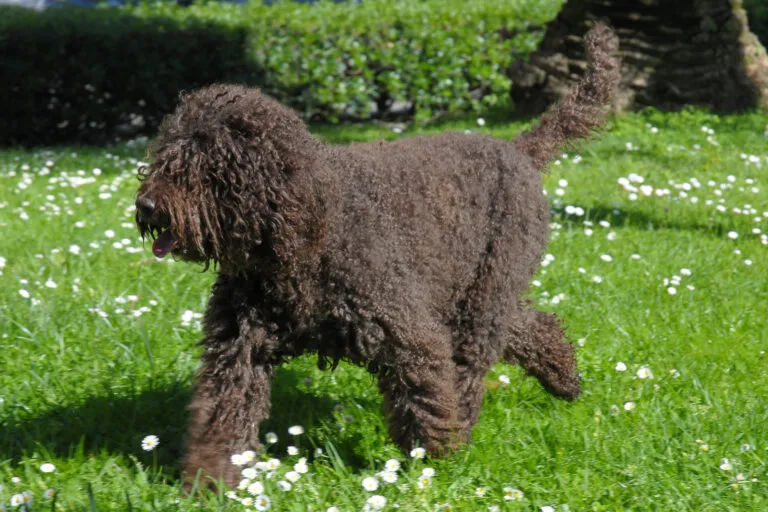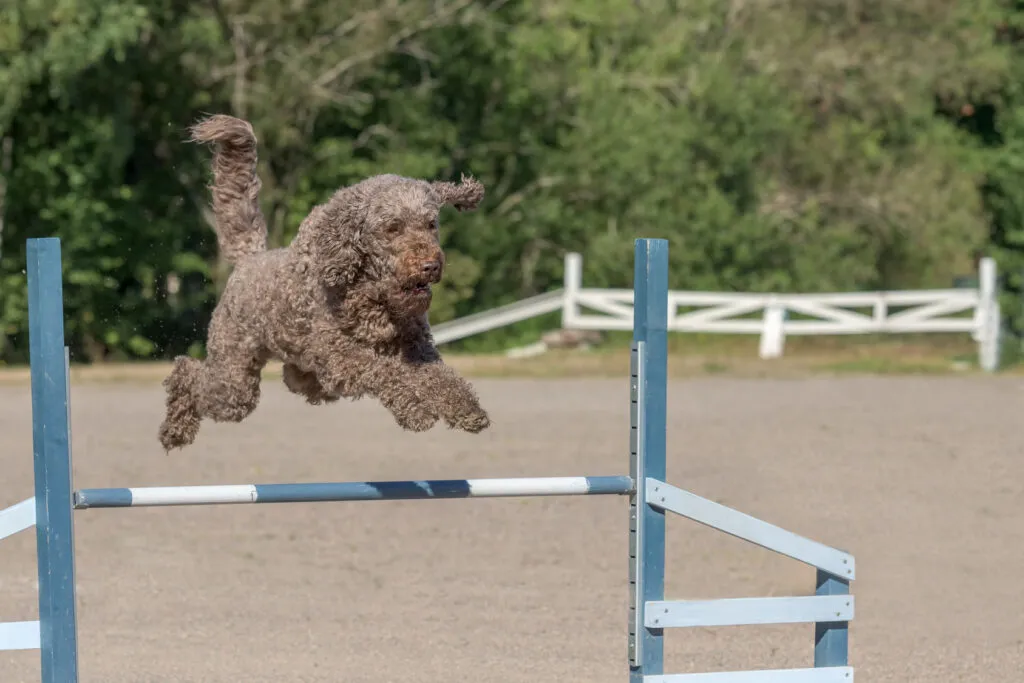Medium Size Poodle
Good-natured, clever, and always ready for shared adventures: a Barbet combines many positive characteristics that make it the ideal companion dog. However, dog enthusiasts should not overlook the fact that it needs a variety of stimulating activities to remain balanced.

© dvr / stock.adobe.com
The Barbet is a medium-sized French water dog with a compact build, curly coat, and a distinctive beard that inspired its name
With up to 65cm at the withers for males – females range from 53 to 61cm – and a stately wavy head, the Barbet is a medium-sized dog with a compact build according to the standard.
The ears are set low and hang down, as does the rod. Its long fur is curly and can form cords – in summer, it is usually clipped. The dog sports a small beard under its chin and a “moustache” over its nose, hence the name “Barbet,” which means “bearded” in French.
The coat can be black, grey, fawn, brown, sand-coloured, or white.
Most Barbets are solid-coloured, though there are also parti-coloured ones.
 © Juha Saastamoinen / stock.adobe.com
© Juha Saastamoinen / stock.adobe.com
When adequately tired out, this clever, wavy-headed dog makes a pleasant and versatile four-legged companion. The Barbet is friendly and balanced, sociable, and fits wonderfully into an active family.
It is always ready for new adventures but remains calm. Loyal to its caregivers, it is usually aloof with strangers.
The Barbet will signal anything unusual but does not tend to bark excessively.
The breed is curious and loves to learn – excellent conditions for an uncomplicated upbringing. However, being sensitive and clever, it quickly spots any inconsistency. Remain firm, even when your Barbet tries to charm its way out of trouble – a “no” should remain a “no.”
Positive reinforcement and varied training lead to success with this sensitive dog. Attend a puppy playtime session with your Barbet to familiarise it with dogs of different sizes and personalities. These sessions often forge lifelong friendships.
Attending a dog training school helps beginners teach fundamental obedience in a playful manner. Experienced dog owners can also benefit from this refresher, which supports your dog’s socialisation.
The rising demand in recent years has led to more Barbets being offered by fraudulent “breeders.”
Remember: choosing a responsible breeder is the optimal foundation for a long, healthy canine life.
Breeders should only breed with dogs tested for hip dysplasia and elbow dysplasia – don’t hesitate to ask for written proof. A healthy weight and proper exercise also contribute to joint health. Certain lines of Barbets have a genetic predisposition to epilepsy and eyelid malposition (entropion).
Reputable breeders trace pedigrees over several generations and select breeding dogs based on health, type, and character. Like many water dogs, Barbets are prone to ear infections; however, you can prevent these with proper attention and care.
A fit Barbet is robust and resilient – be it in cold water or on land. But it does not handle heat well, so it is better clipped in summer.
The breed typically lives between 13 and 15 years.
Treat your Barbet to a dog-appropriate diet – which means plenty of meat in the bowl! Whether you choose dry or wet food, meat should top the ingredient list.
Give your puppy the food familiar from the breeder’s household, even if you plan a later dietary change. Once settled in, gradually mix the new food with the familiar one daily to avoid sensitivity reactions. This method often works for adult dogs too.
For treats, opt for sensible rewards like dried meat snacks or special dental hygiene treats for dogs. As for the main food, avoid grain and sugar, as neither belongs in quality dog food. Occasionally, give your dog chew bones or dried chews like tripe; these are a true chewing delight.
For a medium-sized dog like the Barbet, it’s crucial to let it rest after meals to prevent life-threatening gastric torsion. Therefore, feed it after outdoor activities and before a cosy nap.
Monitor your Barbet’s weight despite its lush fur – if uncertain, weigh it every few weeks to prevent overweight. This can usually be managed without dietetic food – instead, opt for adjusted portions and more exercise. Always ensure your Barbet has access to fresh drinking water.
The wavy coat is worn naturally and is easy to care for, but if your Barbet wears its fur longer, brush it thoroughly at least once a week to prevent tangles. Check the long-haired Barbet daily for any foliage or small branches that may have become lodged in its fur.
Take this opportunity to inspect your four-legged friend’s ears, as Barbets are prone to ear infections. Prevent this by keeping the ears hair-free and using a mild ear cleaner for dogs if they are dirty. At the first sign of infection, see a vet.
If the Barbet’s fur becomes overly dirty, bathe it with a mild dog shampoo. Although the Barbet, as a “water dog,” usually enjoys the water, start this ritual early on with a young dog.
In summer, many Barbet owners shave their dogs – a great relief during hot days, which you should offer your pet. There is also no harm in more frequent shaving, up to four times a year – consult your breeder for advice.
Many owners can learn to clip their dog at home with some practice. Trim the nails if they become too long to avoid painful snagging.
The Barbet can still be used for hunting today – for example, as a retriever in waterfowl hunting, a pointer, or for tracking work.
However, you can keep your Barbet purely as a companion dog if you engage it in other ways. The versatile dog is great for scent work such as search games or mantrailing, dog sports like agility, and, of course, as a companion for long walks or even jogging.
Ensure that any sports activities are matched to your dog’s fitness level – especially young dogs should only train moderately.
This clever and sensitive dog can excel beyond hunting and sport: it also showcases its diverse talents as a guide or therapy dog.
The roots of this water dog trace back to Africa: it is believed to have been brought to France by the Arabs, where, since the Middle Ages, dogs similar to today’s Barbet have been companions to farmers on the French coasts. They guarded homes and farms and were reliable hunting companions for “ordinary people” while other hunting dogs were reserved for the nobility.
This “water dog” hunted ducks and swans since the 16th century.
Gradually, the name “Barbet” became widespread in Europe for all water hunting dogs with wavy hair. By the late 19th century, the French ancestors of today’s Barbet were almost extinct, kept mainly by a few farmers or poachers.
Thanks to its friendly nature, the Barbet saw a resurgence from the 1970s onwards, leading to a stable population today. Besides hunting waterfowl, the French water dog is also kept as a family pet.
Although the Barbet is relatively rare, its influence on the dog world is significant: the breed played a critical role in developing hunting dogs like the Irish Water Spaniel and the Pudelpointer. Even the Briard possibly stems from a cross between the Barbet and Picard. Whether the Poodle descends from the Barbet is not conclusively proven.
This intelligent companion desires an active household and family members with whom it can embark on many activities. Clearly, it is not a dog for couch potatoes! Plan to spend several hours daily on activities with your Barbet.
The friendly breed is excellent for families and can be a wonderful companion for children who have learned to respect animals. The Barbet can also befriend cats if they have been familiarised with them since puppies.
Despite its lush fur, you will hardly find any around your home as the Barbet barely sheds, with the exception of its undercoat. Brush it regularly to prevent the undercoat from spreading around your dwelling.
However, this does not mean an exemption for allergy sufferers: if you might have a pet allergy, test beforehand with your doctor to see if you are allergic to dogs, and consult with them about your options.
Since some allergy sufferers do not react to Barbets, it is advisable to spend plenty of time with representatives of the breed before deciding.
A Barbet can be well-suited to beginners, but they should attend dog training school together. While its size makes it unsuitable for small apartments, it can adapt to city life with enough space and regular excursions to parks or countryside areas. This people-oriented, social dog should not be left alone for too long.
Tip: plan for your new pet’s care during holidays – do you want to bring it along? Many dog-friendly hotels make a hiking holiday in temperate climates with a well-behaved Barbet feasible and enjoyable.
The Barbet has seen a slight increase in popularity outside of France in recent years but remains relatively rare. Do not be tempted to buy a supposed Barbet without papers – rely on reputable breeders whose expertise contributes to the preservation of this charming breed. Such breeders aim to give typical, healthy, and character-strong puppies the best start in life.
Visit the breeder’s home to see the parents and ensure the puppies are lovingly raised. If the breeder asks you questions, take it as a good sign; it shows concern for the future of their puppies. You may have to wait or travel far for a well-bred Barbet, but it is worth it for your future companion!
If you prefer an adult dog, finding a homeless Barbet may require some luck, as the breed remains relatively uncommon outside France. Specialised clubs are the best place to start – if there is no Barbet club in your country, water dog clubs might help.
Some clubs for French pointing dogs also list the Barbet. Perhaps another water dog breed or a mix with similar traits would suit you? Local animal shelters may also have four-legged friends with excellent companion qualities waiting to charm their way into your heart. Be open during your search and thoroughly learn about each animal’s background to find the right match for your lifestyle.
We wish you a wonderful time with your versatile water dog!
Fans of the Bearded Collie agree that those who aren't familiar with this dog breed simply have to get acquainted with it. And those who have experienced how a Bearded Collie bolts across meadows with its flowing fur, how it rolls around full of energy and joy and how it attentively and observantly takes into account its owners wishes become simply addicted to this original dog breed and its unique charm.
The Goldendoodle isn't a breed, but a pairing between Golden Retrievers and Medium or Standard Poodles. Marketed as a low-maintenance dog for allergy sufferers, this hybrid is enjoying increasing popularity amongst dog lovers, similar to the Labradoodle.